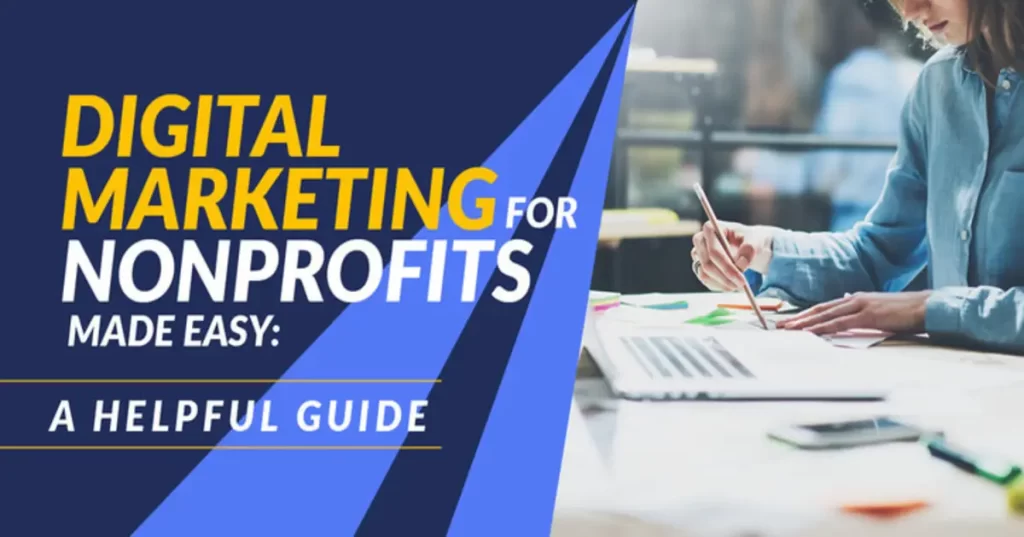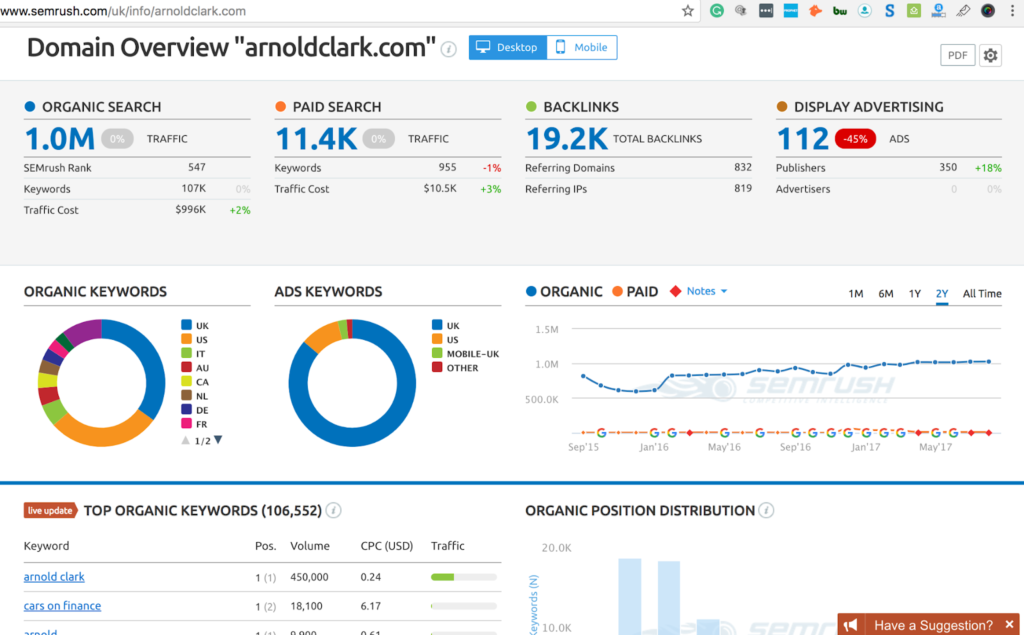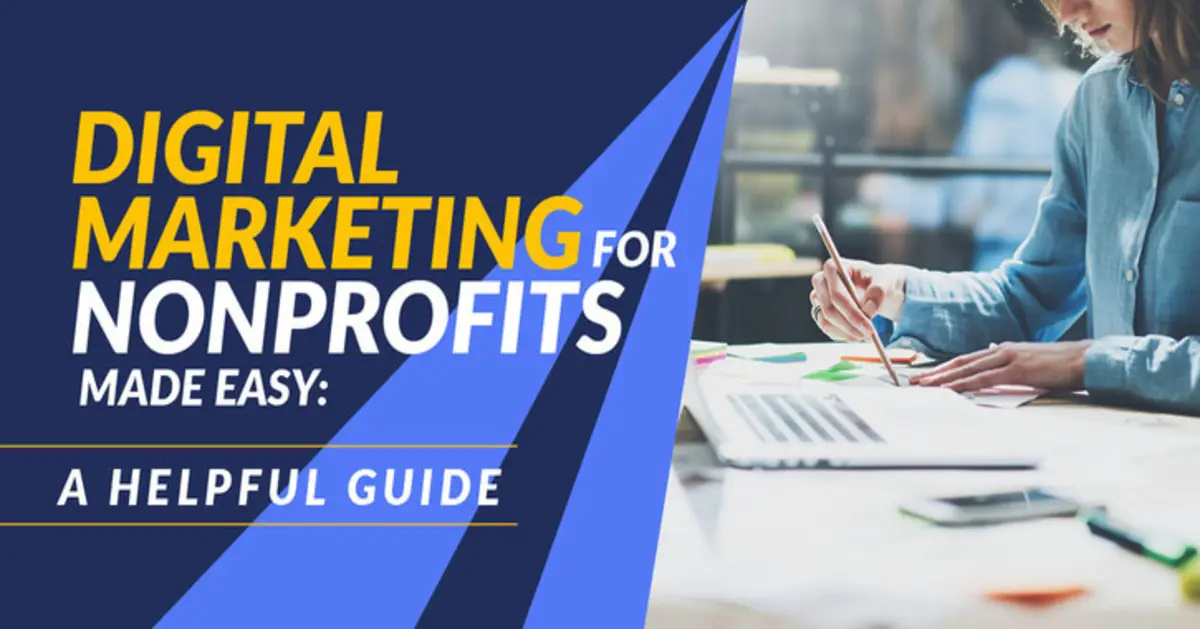
Creating an effective digital marketing strategy can be challenging if you are running a Non-Governmental Organization (NGO) or nonprofit with limited resources. Fortunately, there are numerous digital marketing strategies that you can employ to propel your nonprofit to success.
This article provides a comprehensive guide to digital marketing for nonprofits. We’ll cover everything from defining your goals and target audience to creating a key message and measuring your results.
Table Of Contents
- Benefits of Effective Nonprofit Digital Marketing
- Tips to Consider When Launching a Digital Marketing Campaign for Nonprofits
- Crucial Strategies for a Successful Digital Marketing
- Boost Your SEM for Enhanced Online Visibility
- Enhance Your SEO for Improved Online Presence
- Google Ad Grants For Nonprofits
- Optimize Your Web Design for Better User Engagement
- Consider Your Brand Democracy
- Leverage Social Media
- Content Marketing and Storytelling
- Web Development for Nonprofits
- Email Marketing for Enhanced Outreach
- Collaborate and Partner
- Regular Evaluation and Adaptation
- Frequently Asked Questions
Benefits of Effective Nonprofit Digital Marketing
With valuable data and analytics, nonprofits can measure campaign effectiveness, and the global reach of digital platforms allows them to connect with supporters worldwide. Below, we’ll explore the numerous benefits of a well-executed nonprofit digital marketing strategy.
- Attracts Funding
Online fundraising efforts facilitated through digital marketing channels make it convenient for supporters to donate, ultimately increasing financial resources for the organization.
- Increases Brand Awareness
One of the core objectives of nonprofit digital marketing is to elevate awareness surrounding the organization’s mission, cause, and initiatives. This is achieved through a strategic blend of social media, SEO for nonprofits, and content marketing. Effectively increasing brand awareness in the nonprofit sector involves a multi-faceted approach.
- Builds Long-Term Donor Memberships
Digital marketing for nonprofits is crucial in nurturing long-term relationships with donors. By providing engaging and informative content, nonprofits can maintain ongoing communication with their supporters.
Tips to Consider When Launching a Digital Marketing Campaign for Nonprofits
Here are the essential components to consider for a robust digital marketing strategy tailored for nonprofits:
- Define Your Goals
When launching a digital marketing campaign for your nonprofit, it’s essential to set clear and measurable goals. These goals will serve as the foundation of your strategy and help you track your progress. Some examples of goals you may want to define are:
- Increase online donations;
- Grow email subscriber list;
- Raise awareness;
- Boost volunteer sign-ups;
- Engage on social media;
- Drive website traffic.
By clearly defining these goals, nonprofits can tailor their digital marketing efforts to achieve specific objectives, making their campaigns more focused and effective.
- Know Your Audience
Understanding your target audience is critical in nonprofit digital marketing. Identify who your supporters, donors, and volunteers are. Conduct research to gain insights into their demographics, interests, and online behaviors.
To effectively reach your audience in nonprofit digital marketing, follow these steps to recognize and understand them:
- Identify key stakeholders: Recognize your primary supporters, donors, and volunteers, as these are the key groups you need to engage.
- Conduct audience research: Gather insights into your audience’s demographics, interests, and online behaviors. This can be achieved through surveys, analytics tools, and social media data.
- Segment your audience: Divide your audience into different segments based on their characteristics, such as age, location, or interests, to create targeted campaigns.
- Build personas: Develop detailed personas representing your different audience segments. These personas help in creating content and messages that resonate with each group.
- Analyze engagement data: Examine how your audience interacts with your content and campaigns to refine your strategies over time.
This knowledge will help you tailor your digital marketing efforts to resonate with your audience and engage them effectively.
- Create A Key Message
Your key message should be clear, concise, and compelling. It should communicate your organization’s mission and values and inspire people to take action.
Craft a compelling key message that encapsulates your nonprofit’s mission and impact. It forms the core of your digital marketing content and serves as the unifying theme across all your online channels.
- Choose the Right Platforms
Implement your digital marketing strategy by incorporating both SEO and PPC marketing, strategically choosing platforms like Google Ads or Facebook Ads to complement your organic efforts.
SEO for nonprofits helps improve your website’s visibility on search engines like Google, while PPC allows you to place ads on search engine results pages (SERPs). By using these platforms, you can reach a wider audience and attract more donors.
Select the digital platforms that align best with your audience and goals. Each platform has unique strengths, and a well-thought-out strategy will leverage them effectively.
Recent statistics underscore the digital shift in the nonprofit sector. According to HubSpot, email marketing and social media remain potent channels, inspiring 26% and 25% of donors, respectively, to contribute.
In contrast, other mediums account for just 12% of donations. This emphasis on digital channels is further evidenced by the fact that nonprofits increased their digital advertising budgets by an impressive 19% in 2021 to engage with both new and existing audiences.
Furthermore, the growth of nonprofit email lists is accelerating, with a 7% increase in 2021, a marked rise from 4% and 2% in the preceding years. This data underscores the imperative for nonprofits to strategically utilize digital platforms to optimize outreach and donor engagement.
Source of .hubspot.com/
- Content Creation and Distribution
Create high-quality, engaging content that delivers your key message and supports your goals. Content can include blog posts, videos, infographics, and social media updates. Develop a content calendar to ensure consistency in your messaging and scheduling. Distribute your content strategically across chosen platforms to reach and engage your audience.
- Leverage Social Media
Social media platforms such as Facebook, Twitter, and Instagram can be powerful tools for nonprofits to reach a wider audience, especially with donor memberships.
Some ways of building long-term donor memberships include:
- Sending out regular newsletters;
- Sharing email updates with the donors;
- Keeping social media interactions active.
55% of people who engage with nonprofits on social media take action, and 59% of those donate money. Therefore, consider creating a social media strategy that includes regular posts, engaging visuals, and calls to action.
- Allocate Resources
When planning your nonprofit’s digital marketing strategy, it’s crucial to allocate the necessary resources for successful execution. These include:
- Staffing: Ensure you have the right team members with roles such as social media managers, content creators, email marketing specialists, and data analysts.
- Budget allocation: Determine the financial resources needed for advertising, software subscriptions, and campaign expenses.
- Tools and software: Invest in essential tools and software, such as email marketing platforms, analytics tools, social media management software, and website content management systems.
This includes staffing, budget allocation, and tools or software required for tasks like email marketing, analytics, and social media management.
Ensure that your team is adequately trained and has the necessary skills to implement the strategy.
- Measure and Analyze
Implement tracking and analytics tools to measure the performance of your digital marketing efforts. Measuring the success of your digital marketing campaign is also crucial for identifying areas of improvement and optimizing your strategy.
You can use tools like Google Analytics to track website traffic, engagement, and conversion rates. Donation and volunteer sign-ups are also crucial metrics to keep tabs on. By analyzing this data, you can make informed decisions about your digital marketing strategy and improve your campaign’s effectiveness.
- Engage and Build Relationships
Digital marketing for nonprofits isn’t just about broadcasting messages; it’s about building relationships. Respond to comments, messages, and inquiries promptly.
Engage with your audience through interactive content and discussions. Building meaningful connections fosters trust and loyalty among supporters.
- Iterate and Improve
A successful digital marketing strategy is an evolving one. Continuously evaluate your performance, seek feedback, and be open to making improvements.
Adjust your strategy based on what works and what doesn’t, staying adaptable in the ever-changing digital landscape.
Crucial Strategies for a Successful Digital Marketing
Below are some effective tactics to help NGOs and nonprofits achieve their digital marketing goals.
Boost Your SEM for Enhanced Online Visibility
Boosting your Search Engine Marketing (SEM) strategy is essential for increasing your online visibility and achieving your organization’s objectives.
SEM, including paid advertising like Google Ads, can rapidly elevate your nonprofit’s presence in search results. Some of the ways to accomplish this include:
- Keyword research: Conduct precise keyword research to identify relevant terms that resonate with your audience and cause.
Here’s an example of how you can use a tool like SEMrush to conduct keyword research:

- Craft persuasive Ad campaigns: Create compelling ad campaigns that align with your chosen keywords. Craft ad copy that speaks to the needs and interests of individuals actively searching for related information or causes.
- Optimize landing pages: Ensure your landing pages are optimized around your selected keywords. This improves the user experience and increases the likelihood of conversions.
- Strategy refinement: Based on performance data, refine your SEM strategy to continuously improve results and maintain relevance.
By implementing these tips, nonprofits can enhance their SEM strategies, increase online visibility, and effectively reach their target audience to further their mission and cause.
Enhance Your SEO for Improved Online Presence
Search Engine Optimization (SEO) is a crucial component of digital marketing. It is pivotal for improving your online visibility and attracting a more substantial organic audience.
By optimizing your website for search engines, you can improve your online visibility and attract more visitors. According to a report by HubSpot, 75% of people don’t scroll past the first page of search engine results.
Therefore, ensuring that your website appears on the first page of search results is essential. You can achieve this by using relevant keywords, creating high-quality content, and optimizing your website’s structure.
Conduct thorough keyword research to identify the most relevant and high-traffic keywords in your niche. Optimize your website content, including meta tags, headings, and quality content creation, to align with these keywords.
Moreover, you should also focus on building high-quality backlinks from reputable websites and improving the overall user experience on your site. Consider enlisting professional Search Engine Optimization (SEO) services to supercharge your SEO strategies for your nonprofit.
Google Ad Grants For Nonprofits
Google Ad Grants is a benevolent program from Google designed to support nonprofit organizations in their digital marketing endeavors. By offering eligible nonprofits up to $10,000 per month in free advertising credits, these organizations can prominently showcase their causes on Google’s search results pages.
This not only aids in increasing their visibility to potential donors and volunteers but also provides them the means to drive awareness about pressing issues or campaigns they’re championing. The program is structured to ensure that participating organizations can maximize their reach, making their advertising campaigns as effective as possible.
Through this generous initiative, Google aims to foster positive change, giving nonprofits the digital tools to expand their influence and achieve their goals.
Optimize Your Web Design for Better User Engagement
Effective website design and development are instrumental in creating a positive first impression. Your website is often the first point of contact for potential supporters, donors, and volunteers.
Ensure your web design is user-friendly, mobile-responsive, and visually appealing. Make information about your organization, mission, and impact easily accessible. An intuitive website design can significantly improve user engagement and encourage visitors to take action in support of your cause.
Redesigning your website is crucial to resonate with your evolving audience, ensure optimal conversions, and implement a clear, user-friendly funnel.
A contemporary, intuitive design not only looks appealing but also effectively guides visitors towards desired actions, bolstering support for your cause.
Adding multi-lingual support broadens your audience base, making your platform universally accessible and inclusive. Periodic updates are vital to maintain relevance and engagement in the ever-evolving digital landscape.
WWF’s website, www.worldwildlife.org, stands out as a well-optimized example. It engages visitors with captivating visuals, offers easy navigation, and encourages action with clear calls to donate and get involved. The site is mobile-responsive and provides comprehensive information on wildlife conservation.
Source of https://www.worldwildlife.org/
Consider Your Brand Democracy
In the digital age, brand democracy is key. Encourage your supporters to become advocates for your nonprofit by providing them with the tools and content they need to spread your message.
Create shareable social media content, infographics, and videos that highlight your organization’s work. Empower your supporters to actively participate in your digital marketing efforts, amplifying your reach and impact.
Leverage Social Media
Social media marketing platforms are powerful tools to engage with your audience and share your mission. Create a strong social media presence by posting regularly, responding to comments and messages, and running targeted campaigns.
Use platforms like Facebook, Twitter, Instagram, and LinkedIn to connect with supporters, share stories, and mobilize action.
For example, the American Civil Liberties Union (ACLU) is a nonprofit organization that has been using social media effectively to promote its mission of defending and preserving individual rights and liberties guaranteed by the Constitution and laws of the United States.
The organization has a strong presence on various social media platforms, including Instagram and YouTube.
This heightened visibility you get from these methods ensures that your mission is seen by a broader audience, increasing the chances of individuals becoming advocates and supporters.
The World Wildlife Fund (WWF) is a nonprofit organization that has been using content marketing effectively to promote its mission of conserving nature and reducing the most pressing threats to the diversity of life on Earth.
Its content marketing strategy is effective because it uses a variety of content formats to engage with its audience. For instance, it uses Twitter to share news updates, engage with followers, and promote its campaigns.
According to Nonprofit Tech for Good, 71% of nonprofits globally acknowledge the effectiveness of social media for online fundraising. In addition, 29% of online donors cite social media as the primary source of inspiration for their charitable contributions.
Source of https://www.nptechforgood.com/
Content Marketing and Storytelling
Content marketing is an effective way to engage with your audience and build trust with potential donors. By creating high-quality content that resonates with your target audience, you can establish your organization as a thought leader in your field.
Storytelling is an integral part of content marketing. By sharing stories that highlight your organization’s impact, you can inspire people to take action and support your cause. Craft compelling narratives that highlight the impact of your work and the stories of the people you serve.
Utilize blog posts, success stories, and multimedia content to convey your message authentically. Storytelling humanizes your nonprofit and connects emotionally with your audience.
Web Development for Nonprofits
A well-developed website is crucial for the success of your digital marketing campaign. Your website should be user-friendly, visually appealing, and optimized for search engines.
It is a no-brainer that the most popular content management system (CMS) used in web development for nonprofits is WordPress. It shines as the preferred platform, particularly for SEO-focused content creation and management.
WordPress has a user-friendly interface and is well-known for its extensive features, making it an ideal choice, ensuring that your content is presented professionally and in an easily navigable manner. This enhances your outreach and engagement efforts.
Email Marketing for Enhanced Outreach
Email marketing remains a highly effective digital marketing strategy for nonprofits. Build and segment your email list to send tailored messages to different segments of your audience.
Regularly update supporters with newsletters, fundraising appeals, and updates on your projects.
Moreover, you should personalize your emails to make recipients feel valued and engaged. According to Salesforce, over 60% of nonprofit supporters feel like the emails they get from the nonprofits they wish to support are not personalized. This is quite a high percentage that can significantly impact your nonprofit’s growth.
Incorporating the latest digital marketing trends, such as automation and personalization, can elevate the effectiveness of email marketing for NGOs.
Collaborate and Partner
Consider collaborations and partnerships with other organizations and influencers that align with your mission.
Coordinated campaigns and joint initiatives can expand your reach and bring new supporters to your cause. Building a network of allies in the digital space can be highly beneficial for an NGO’s digital marketing efforts.
Regular Evaluation and Adaptation
Digital marketing is dynamic, and strategies need to evolve with changing trends and technologies.
Regularly evaluate the performance of your digital marketing campaigns, seek feedback from supporters, and be open to making improvements. Flexibility and adaptability are key to long-term success in the digital landscape.
Frequently Asked Questions
SEO in nonprofit digital marketing improves online visibility by optimizing content and websites for search engines, helping nonprofits reach a wider audience and attract supporters.
Yes, nonprofits can benefit from online advertising, as it allows targeted outreach, raising awareness, and attracting donors and supporters cost-effectively.
Nonprofits leverage social media through engaging content, campaign promotion, user-generated content, and responsive interaction to build a community of supporters.
Ensure that your goals and objectives are SMART (Specific, Measurable, Achievable, Relevant, and Time-bound). For instance, an example of a SMART goal can be increasing online donations by 20% in six months.
Consider data privacy, transparency, honesty, donor consent, and respecting supporter preferences to ensure ethical and legal compliance.
Measure success through KPIs like website traffic, conversion rates, email engagement, social media metrics, ROI from online advertising, donor growth, and fundraising performance. Regular analysis guides strategy adjustments.

